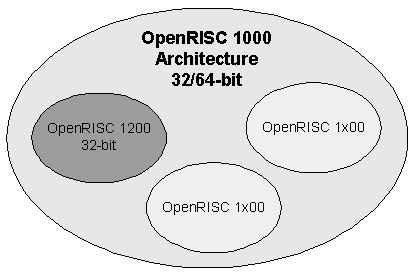OpenRISC 1000 (old)
Introduction
The aim of this project is to define the basic OpenRISC 1000 architecture and to add improvements and extensions in the future.
OpenRISC 1000 is architecture for a family of free, open source RISC processor cores. As an architecture, OpenRISC 1000 allows for a spectrum of chip and system implementations at a variety of price/performance points for a range of applications. It is a 32/64-bit load and store RISC architecture designed with emphasis on performance, simplicity, low power requirements, scalability and versatility.
OpenRISC 1000 architecture targets medium and high performance networking, embedded, automotive and portable computer environments.

Performance features include fully 32/64-bit architecture, vector, DSP and floating-point instructions, powerful virtual memory support, cache coherency, optional SMP and SMT support and support for fast context switching. Architecture defines several features for networking and embedded computer environments. Most notable are several instruction extensions, configurable number of general-purpose registers, configurable cache and TLB sizes, dynamic power management support and space for user provided instructions. OpenRISC 1000 architecture is a predecessor of more powerful and richful next generation OpenRISC architectures.
IMAGE: arch.gif
FILE: arch.gif
DESCRIPTION:
Features
OpenRISC 1000 architecture includes the following principal features:
- A completely open and free architecture
- A linear, 32-bit or 64-bit logical address space with implementation specific physical address space
- Simple and uniform-length instruction formats featuring different instruction set extensions:
- OpenRISC Basic Instruction Set (ORBIS32/64) with 32 bits wide instructions aligned on 32-bit boundaries in memory and operating on 32 bits and 64 bits data
- OpenRISC Vector/DSP eXtension (ORVDX64) with 32 bits wide instructions aligned on 32-bit boundaries in memory and operating on 8, 16, 32 and 64 bits data
- OpenRISC Floating-Point eXtension (ORFPX32/64) with 32 bits wide instructions aligned on 32-bit boundaries in memory and operating on 32 bits and 64 bits data
- Two simple memory addressing modes where memory address is calculated with:
- Addition of register operand and signed 16-bit immediate
- Addition of register operand and signed 16-bit immediate followed by update of register operand with calculated effective address
- Most instructions operate on two register operands (or one register and a constant), and place the result in a third register
- Shadowed or single 32-entry or narrow 16-entry general purpose register file
- Branch delay slot for keeping pipeline as full as possible
Status
- Basic architecture is defined in OpenRISC 1000 Architecture Manual and is not being changed anymore
- For architecture evaluation and software development an architecture simulator is available. See or1ksim page
- First implementation is available. See OR1200 page. For roadmap look at the following figure

If you would like to help with the development, please contact the developers.
Documentation
Latest OpenRISC architecture manual is available from the OpenCores CVS under module name or1k/docs:
- OpenRISC 1000 Architecture Manual (PDF, 1.5MB)
- OpenRISC 1000 Architecture Manual (MS Word, 5MB)
Mailing List
To participate in the development or simply to discuss OR1K architecture issues, go to the openrisc mailing list.
Current Developers
The team working on the OpenRISC architecture:
- the OpenRISC maintainers
Past Contributors
These are the people currently not working on the OpenRISC, but have contributed in the past:
- Johan Rydberg, jrydberg@opencores.org
- Chen-Min Chen, jimmy@opencores.org
- Greg McGary, greg@mcgary.org
- Chris Ziomkowsi, chris@opencores.org
- Marko Mlinar, markom@opencores.org
- Simon Srot, simons@opencores.org
- Matan Ziv-Av, matan@opencores.org
- Damjan Lampret, damjanl@opencores.org
Page Maintainer
This web page is maintained by Marcus Erlandsson.
